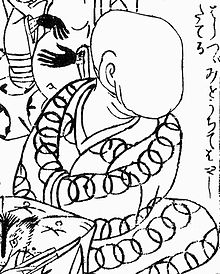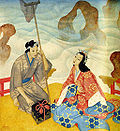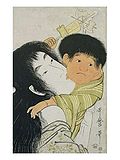- Noppera-bō
-
 A Noppera-bō, by Asai Ryōi in his Otogi Boko
A Noppera-bō, by Asai Ryōi in his Otogi Boko
The Noppera-bō (のっぺら坊 Noppera-bō), or faceless ghost, is a Japanese legendary creature. They are sometimes mistakenly referred to as a mujina, an old Japanese word for a badger or raccoon dog. Although the mujina can assume the form of the other, noppera-bō are usually humans. Such creatures were thought to sometimes transform themselves into noppera-bō in order to frighten humans. Lafcadio Hearn used the animals' name as the title of his story about faceless monsters, probably resulting in the misused terminology.
Noppera-bō are known primarily for frightening humans, but are usually otherwise harmless. They appear at first as ordinary human beings, sometimes impersonating someone familiar to the victim, before causing their features to disappear, leaving a blank, smooth sheet of skin where their face should be.
Contents
Noppera-bō in folklore
There are two primary stories about the noppera-bō.
The Noppera-bō and the Koi Pond
This tale recounts a lazy fisherman who decided to fish in the imperial koi ponds near the Heiankyo palace. Despite being warned by his wife about the pond being sacred and near a graveyard, the fisherman went anyway. On his way to the pond, he is warned by another fisherman not to go there, but he again ignores the warning. Once at the spot, he is met by a beautiful young woman who pleads with him not to fish in the pond. He ignores her and, to his horror, she wipes her face off. Rushing home to hide, he is confronted by what seems to be his wife, who chastises him for his wickedness before wiping off her facial features as well.
The Mujina of the Akasaka Road
The most famous story recollection of the Noppera-bō comes from Lafcadio Hearn's book Kwaidan: Stories and Studies of Strange Things. The story of a man who travelled along the Akasaka road to Edo, he came across a young woman in a remote location near Kunizaka hill, crying and forlorn. After attempting to console the young woman and offer assistance, she turned to face him, startling him with the blank countenance of a faceless ghost. Frightened, the man proceeded down the road for some time, until he came across a soba vendor. Stopping to relax, the man told the vendor of his tale, only to recoil in horror as the soba vendor stroked his face, becoming a noppera-bō himself.
There are other tales about noppera-bō, from a young woman rescued from bandits by a samurai on horseback whose face disappears; to stories of nobles heading out for a tryst with another, only to discover the courtesan is being impersonated by a noppera-bō.
Noppera-bō in popular culture
- In the Dungeons and Dragons fantasy role-playing game system, a noppera-bō (also called mujina there) appear as monsters which can create the illusion of a face to appear harmless, and is strong enough to wield even two-handed swords in one hand. In the Fabled Lands role-playing series, it is even capable of stealing his victims' faces, which it hides in a secret lair.
- The Studio Ghibli film Pom Poko features a modern retelling of The Mujina of the Akasaka Road. In one scene, a police officer comes upon a beautiful young woman (who is actually a shapeshifting tanuki) crying on the side of the road. He attempts to console the young woman, but when she turns to him, she has a completely featureless face. The terrified officer runs to a police box to tell his fellow police officer what happened, but the officer, like the soba vendor, strokes his face and becomes a noppera-bo himself. The man then runs to a convenience store (the modern-day equivalent to the soba stand), and tries to tell the people in the store what happened, but everyone in the store then becomes a noppera-bo.
- The 2005 movie The Great Yokai War briefly features a noppera-bo who appears to the main character as his sister, before turning to reveal a featureless face.
- In Changeling: The Lost, the noppera-bō is a type of hobgoblin. They impersonate others to gain the trust of travelers, then lead them into frightening and dangerous situations. When discovered, they reveal their faceless true form for a final scare.
- In the game Yume Nikki, the main character, Madotsuki, can gain the power to transform into a noppera-bō.
- The game M.U.G.E.N. has a noppera-bō character named Noroko.
- One episode of Inuyasha has a yōkai named No-Man who appeared to be a noppera-bō, for he had no face.
- The third arc of the anime Mononoke (モノノ怪) was titled Noppera-Bou, and focused around a woman, and a mononoke that used noh masks because it had no face.
- In Animal Crossing the character Blanca has a similar appearance to the Noppera-Bō, typically having a perfectly blank face. However instead of scaring off the player, she invites them to draw her a new face, which is then wiped off whenever someone new draws one on for her.
- It's likely not intentional, but the DC Comics character known as the Question takes on the appearance of a Noppera-bo, lacking a face. The effect is achieved by a skin-like mask.
- A Dick Tracy villain called The Blank is one of these.
- The Noppera-bō is featured as a monster of the day in the 1995 Super Sentai series Ninja Sentai Kakuranger.
- In Adventure Quest Worlds, you will get to fight samurai and ninja Nopperabo on the Yokai Isle.
- In chapter 606 of the Japanese manga One Piece, the Straw Hat Pirates meet a faceless crab on their way to the Fishman island, the crew navigator Nami shouted calling it a Noppera-Crab.
- In the movie of Hetalia, Hetalia:Paint it, White!, the primary antagonists are Noppura from the planet Pict.
Recent reports
Though most sightings of noppera-bō tend to be historical, 20th century reports have not been uncommon, both in Japan itself as well as locations where Japanese have emigrated, most notably the U.S. state of Hawaii and where the term "mujina" vice "noppera-bō" is most deeply ingrained. Among the most recent reports:
- On May 19, 1959, Honolulu Advertiser reporter Bob Krauss reported a sighting of a mujina at the Waialae Drive-In Theatre in Kahala. Krauss reported that the witness watched a woman combing her hair in the women's restroom, and when the witness came close enough, the mujina turned, revealing her featureless face. The witness was reported to have been admitted to the hospital for a nervous breakdown. Noted Hawaiian historian, folklorist and author Glen Grant, in a 1981 radio interview dismissed the story as rumor, only to be called by the witness herself, who gave more details on the event, including the previously unreported detail that the mujina in question had red hair.[1][dead link] The drive-in no longer exists, having been torn down to make room for a subdivision.
- Grant has also reported on a number of other mujina sightings in Hawaii, from Ewa Beach to Hilo.
See also
References
- ^ "The Faceless Woman". Archived from the original on 2007-12-31. http://web.archive.org/web/20071231182409/http://www.geocities.com/area51/hollow/6166/faceless.html. Retrieved 2008-10-01.
External links
- Entry on "nopperabou" at The Obakemono Project
- Entry on "mujina" at The Obakemono Project
- Lafcadio Hearn's story at Monogatari.org
- Pierre Wayser's flash video of the mujina story (French)
- webpage regarding the 1959 and 1981 reports of the Waialae Mujina
- Discussion of the confusion of terms brought about by the titles of Hearn's stories.
Japanese folklore 
Folktales 
Text collections Legendary creatures Mythology in popular culture · Legendary creatures Categories:- Japanese legendary creatures
- Urban legends
- Shapeshifting
- Mythic humanoids
Wikimedia Foundation. 2010.
